A well-run organization, with highly motivated and aligned people, is a powerful form of high art. It includes the performance art of your people delivering services and coordinating activities at scale and it has artifacts, symbols, and physical art that have the potential to leave a profound impression on the people it touches. The art manifests in and through all of the layers of the organization’s culture.
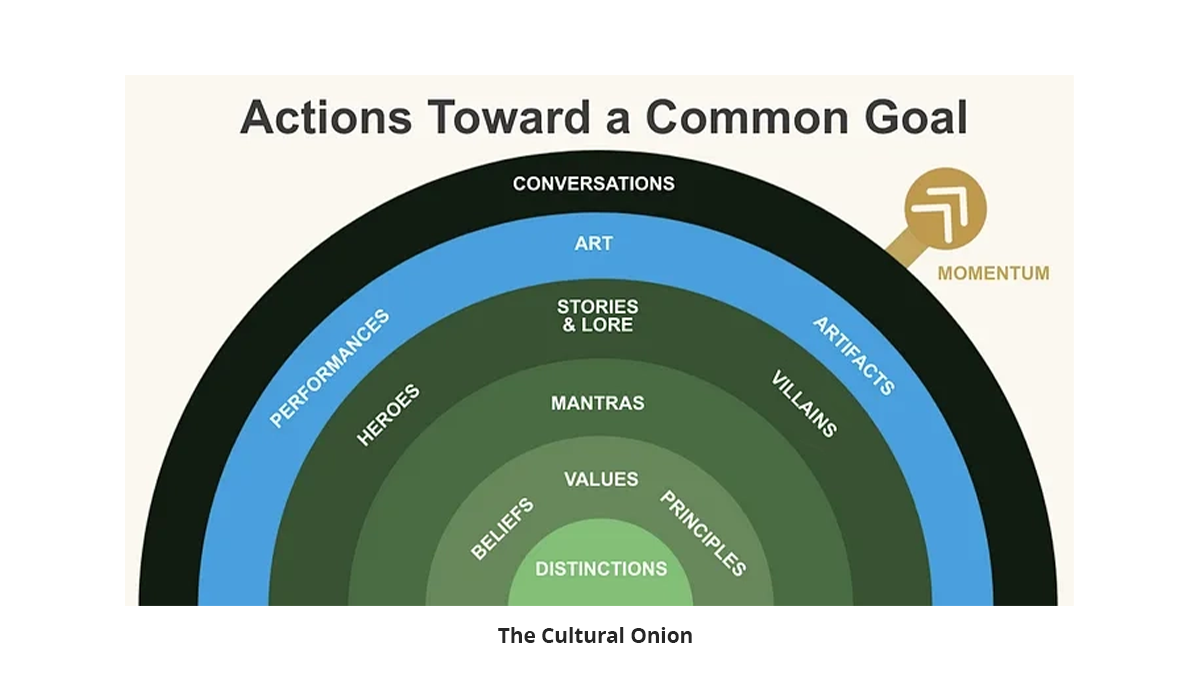
Culture is a lot like the bulb of an onion. It has many interesting layers and if you leave it on the shelf for too long, and don’t pay attention, it will surely rot. It grows underground, mostly out of sight, and it serves as somewhat of a mediator between the roots of the plant which provide it water and nutrients, and the leaves which reach for the sky and convert carbon dioxide into oxygen. When it is ready to reproduce and grow, it sprouts a stem with an intricate, colorful, and aromatic flower. The culture of a company is similar in that it has many complicated layers. When it is not healthy, the effects are sometimes hidden from the outside world for a long time and the onion can rot from the inside out. This can actively sap the creative energy from everyone involved, turning a talented group of people into a collection of automatons churning out widgets for dimes and rushing out the door when the bell rings to find their purpose elsewhere.
When an organization’s culture is healthy, it manifests as a deeply coordinated work of human art. Organizations made of people have the potential to be a sophisticated, complicated, and beautiful form of human art. According to the Internet, Peter Ferdinand Drucker (1909–2005) said:
Culture Eats Strategy for Breakfast
As with many quotes, which are prominently misrepresenting their authors, I cannot find any evidence of this one in his writing. This quote, however, does spark a series of fantastic questions, which I have seen many leaders struggle with. I will try to answer some of these questions with regard to culture as it pertains to the construction of organizations:
- What is culture?
- What are the characteristics of a good culture?
- How does culture relate to the strategy of the organization?
- How does culture impact outcomes, like profit?
- Is culture important?
- How can I impact the culture of my organization?
Like most important words in the English language, it is difficult for a group of people to operate on it purposefully without a shared definition. For the purposes of our discussion, I will use this definition of culture in a modern organization. Culture is:
The context that binds people together and results in actions toward a common goal.
Culture is the context that a group of people share. It can be positive or negative, optimistic or pessimistic, risk-averse or risk-taking. It can be hard to describe what culture is, so leaders sometimes avoid discussing it and allow it to happen by default. I have observed many leadership teams work to craft powerful missions, visions, and values. These words, which hopefully serve as the foundation of a powerful culture, are not the complete context that binds people together toward a common goal.
A powerful culture is one that creates strong connections between individuals and the group.
Think “Connection over content” as a mantra as you steward the different layers of your culture. When you think and lead with this mantra, the mode of interaction is less relevant, i.e., remote vs. in-person working.
The larger an organization becomes, the more complicated its culture. Every group of two or more people with a common goal has a culture. Culture exists in every family, in every neighborhood, in every nation, in every company, and within every department within every company. Unique cultures exist in friend groups, church groups, families, sports teams, hobby groups, and in any other assembly of people that intend to accomplish something together. Consider this thought experiment in the context of sporting teams:
Ask the following questions to three athletes, from three different sports: soccer, volleyball, and baseball.
- When you close your eyes and picture a ball, what do you see?
- When the term “hit” is spoken, what do you hear?
- When someone yells “score,” what sequence of events plays out in your mind?
These are powerful distinctions with very different meanings for each of these athletes in the context of their teams. Without a shared understanding of the meaning of these contextual elements, like a ball, a hit, the score, or the rules, it would be challenging, if not impossible, to align a team to win a game. The same logic applies to the different teams inside of your organization. The larger an organization, the more deeply nested cultures can be. The more specific knowledge exists closer to the production of your products and services. It is for these teams of people that it is most important to have clear and powerful language and distinctions that are used to do their jobs, onboard new team members, and be more effective.
Using this logic, it is easy to see how important it is for each team to have a culture. To maximize the effectiveness of an organization, each independent team needs to have components that are unique and specific to it, while staying true and aligned to the broader cultures that it thrives within. All of this context that manifests as a group’s culture, occurs in the language.
Language
Healthy and powerful cultures emerge from motivated teams that start with a strong foundation in language. But they must be nurtured to thrive. Language might be the single most powerful tool organizations have and it is clearly at the core of all cultures. An organization’s culture manifests and can only thrive through the language that gets used and repeated. The more purposeful a leader is at curating, refining, and refreshing the language used by the people in an organization, the stronger the culture will get for that organization. If you try to force-fit language when it is not working, however, it will likely backfire. Leadership teams have to start somewhere; thus, they craft the language they believe will inspire their teams and paint it on the walls. It is, however, foolish to think that the language that a leadership team creates, no matter how good it is or how well-intentioned the leaders are, will stay static forever.
It might even be more foolish to believe that any small group of people can come down off the mountain top with their values etched into a stone and lead the people in the organization to magically live into those values. I have seen some leaders resort to using external, low-quality fear-based motivation to try to enforce the use of their chosen language, but I have not yet seen that type of leadership be sustainable. I have also seen attempts at incorporating language into performance management, and reward and recognition systems. While this can be a powerful way to “establish” your language, it can also distort behaviors if it is done without a more comprehensive and involved approach to amplifying and suppressing what is and is not working in your culture.
The way language manifests in an organization should start with a purposefully created lexicon by a well-intended leadership team, but as the organization grows, the culture must be allowed to evolve and change. It will do so without the permission of the leadership, and it will evolve chaotically if no one is nurturing it. It will also diffuse the more an organization grows, the more people it has in its ranks, and the broader the organization is distributed. There is no way around this. Growth invariably leads to a diffusion of culture.
Your culture must be allowed to be created and expand as the organization grows and diversifies.
Whatever is written down by the leadership team can only serve as the foundation. The culture must change and evolve over time in order to thrive. The values and mantras that are painted on the walls, but not used, are still valuable because they influence conversations. But it is more valuable to understand, through observation, which values and mantras are actually being lived and espoused by the leaders in your organization. An organization’s culture exists in the context that is spoken and lived, not in the context that is written down. When you hear the language showing up in repeated mantras, in the stories that are used and told, in the art and symbols that are repeated, and in the conversations that occur in the hallways when the leadership is not around, you know that the culture is being powerfully curated.
Leaders cannot create culture, they can only set the foundation for it, set the boundaries around it, live the example, and nurture it.
Nature vs. Nurture
An organization is not born with a great culture and an organization’s culture does not emanate solely from its founders. David Packard discussed a method of leadership that he called “Management by Walking Around,” in detail in his book about the building of HP. It is fundamental for leaders to maintain a real pulse on what is happening in their businesses by talking to real customers and real front-line workers on a regular basis. There are a few better ways for the leadership to understand how the culture is operating, identify what is working, and find things that are not working. They have to be authentically listening and observing at the ground level with some reasonable cadence.
In order to scale this, demonstrate the importance of staying connected to the leaders that you are serving below you in the organization by getting out there. When you are connected, you can expect the people you lead to stay connected. Leaders who demonstrate that they are committed to walking the walk are most respected by the people they lead. The words must be used in the proper context by the leaders if the people in the organization are to follow and use them in the same way. Otherwise, the missions, visions, and values that we set forth have no power. When a leader professes personal integrity, for example, but behaves badly when few are looking, it is only a matter of time before the culture is undermined. Those stories of incongruity with the values will become the stories that are told, and they will influence the culture in ways that will be difficult to suppress. The SAY:DO ratio of leaders needs to be very close to 1:1.
Components of Culture
A culture manifests as a collection of language elements, artifacts, art, traditions, and performances that live in its context. It starts and grows out of a shared lexicon and moves through the stated beliefs and values that are authentically espoused, the mantras that are purposefully used, and the stories and lore that are told on a recurring basis. These language tools lead to the conversations that ultimately spark the actions that make a culture powerful.
Culture is heard in the language that is spoken and felt in the actions that it inspires. You have a positive culture when there is openness and optimism around the language. You have evidence of a positive culture when the team is highly motivated toward positive action. Culture starts with the words that we choose to make important and the words that we choose to ignore. It becomes powerful when it manifests in positive actions toward the goals that are set by your team. That is momentum.
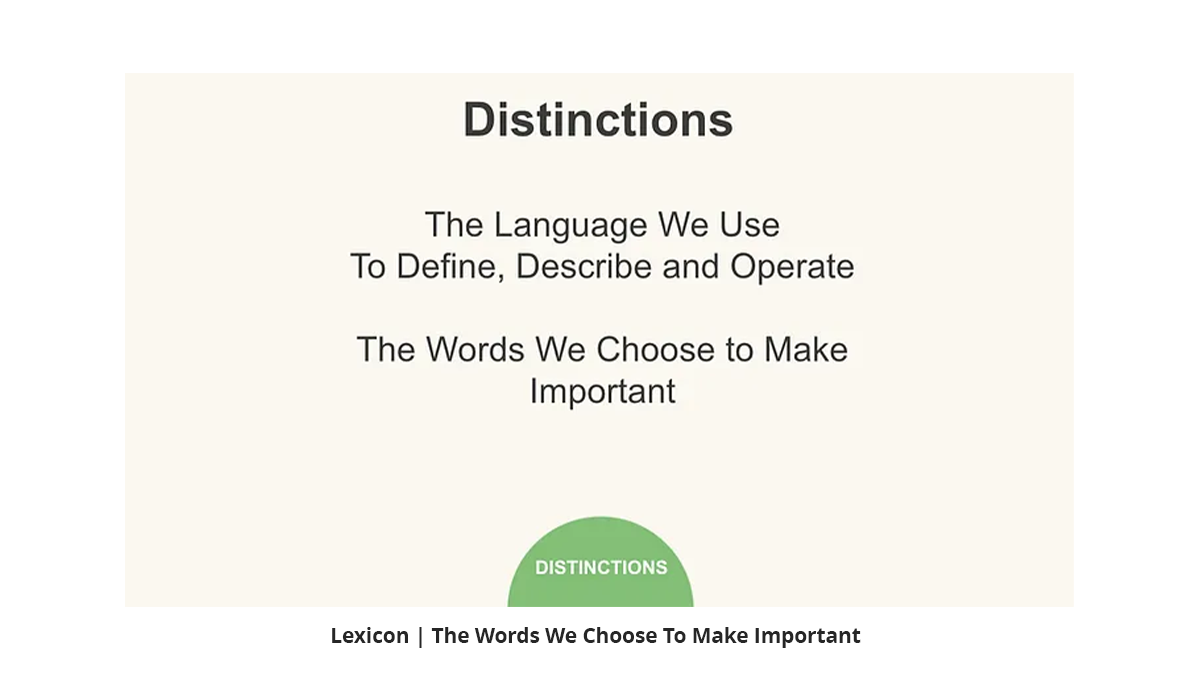
Distinctions | Lexicon | Words. We choose what words we make important. When we are powerful with those words, we take the time to understand and define them in a meaningful way with our teams, and work toward more powerful shared usage. Chalmers Brothers, in his book, “Language and the Pursuit of Leadership Excellence” explains the importance of language as a leadership tool to create the future. When you chose important words like “Trust, Loyalty, and Advocacy” to represent your goals, it has a powerful impact on the actions taken. As I discussed before, the ability to use words, language, and communication skills are the most powerful tools that all the great leaders of our collective history had in common. It is their words that live on. It is their words that continue to inspire change today. In some cases, they are still motivating action, thousands of years later.
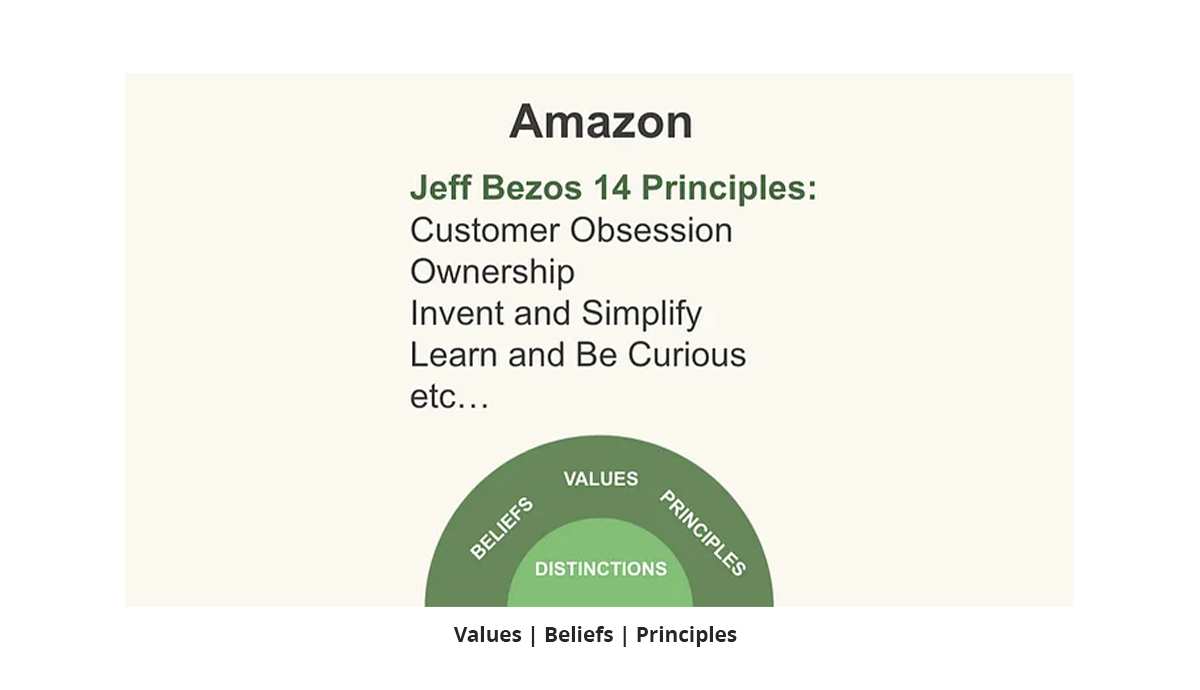
Values | Shared Beliefs | Principles. Many leaders have been taught the importance of distinguishing values to align around. I have often seen values expressed as a set of four to twelve words or phrases that sometimes get defined and are less often measured. It is dangerous to articulate them for the sake of posterity without persistent and purposeful monitoring and curation. When they are acted upon consistently by the leadership and used in conversations, there is a much stronger chance that they will take hold. When they are not, leaders must act fast to rectify their behaviors or the behaviors they see that are incongruent with the stated values. When the values incorporate key language that we value as leaders, they will become more important and sustainable in the culture. In this layer, organizations might articulate their mission or vision statements through the written word. They might also establish written “Principles” as Ray Dalio describes in his work or as Jeff Bezos does at Amazon.
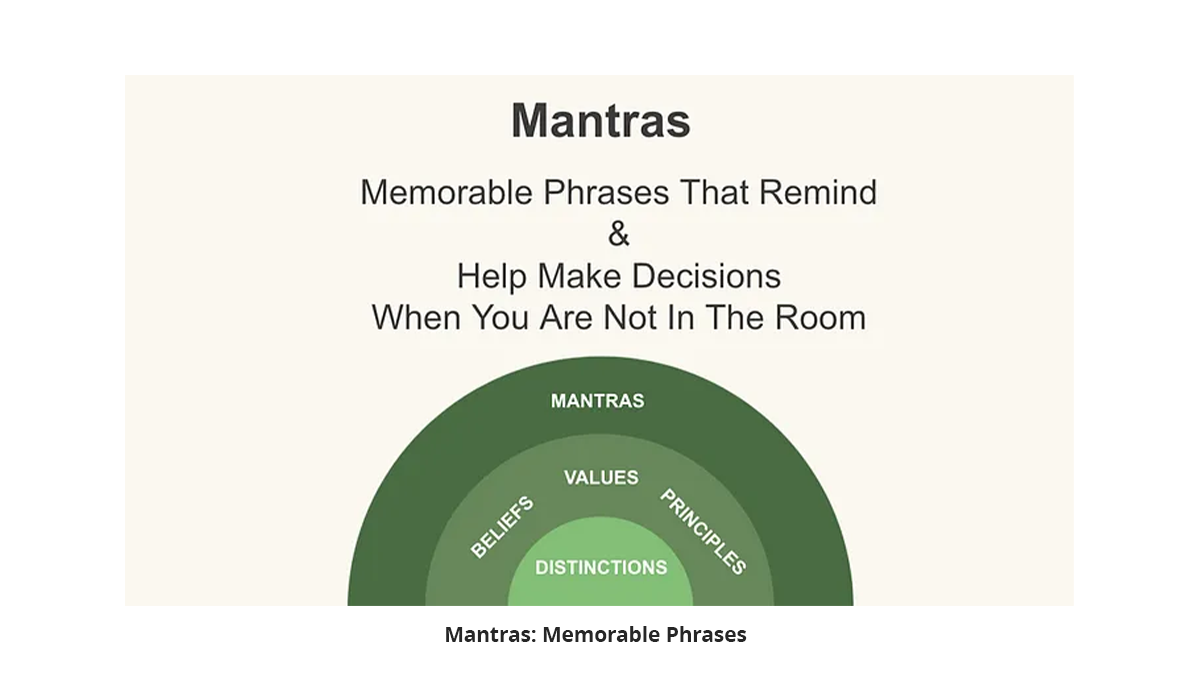
Mantras | Short Sayings. When working really well, these manifest purposefully in parts of a mission or vision statement. When they are rarely remembered and not used at the ground level in your organization, however, they will be discarded. The mantras that get used and repeated in your business form the conversational context for a powerful culture. In their most powerful form, the mantras that are repeated are those that work for the teams using them while also supporting the shared mission and values in a clear way. Daniel Coyle describes how this has applied in the successful companies that he studied in “The Culture Code.”
Each of your stated values, for example, could have an associated mantra or two. The best of them are those that inform decision-making at all levels of the organization, including the front lines. I see an organization’s mission statement as a primary guiding mantra. It should be memorable, pneumonic, and specific enough to be meaningful.
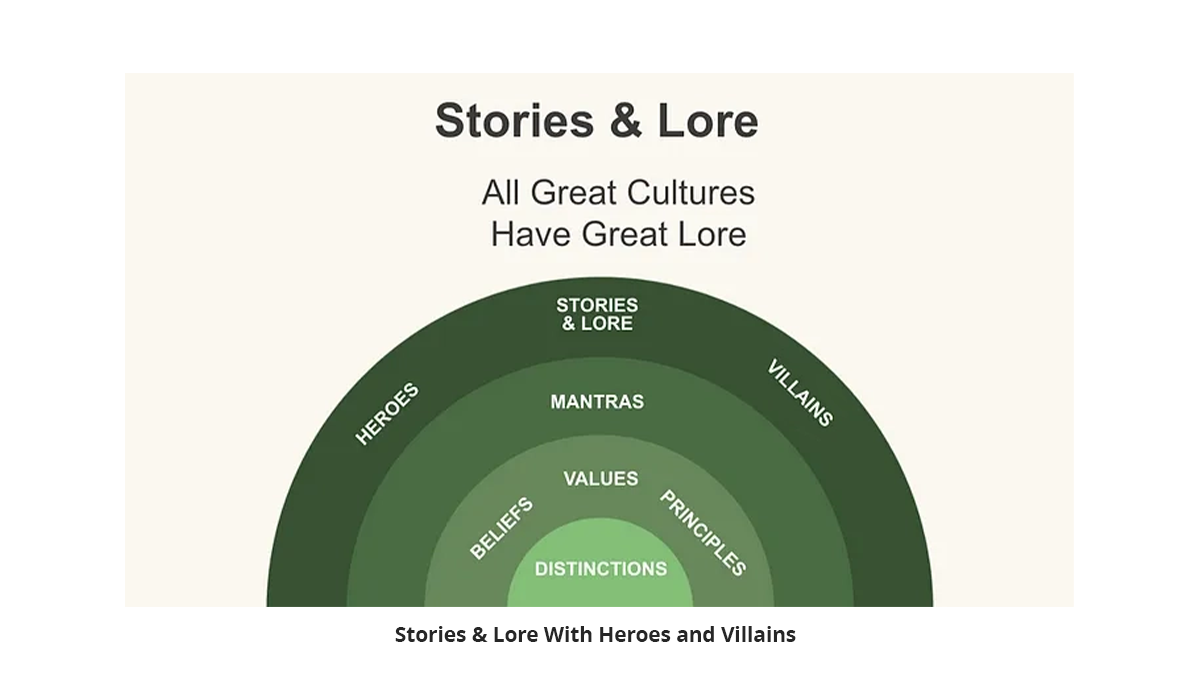
Stories | Lore. The stories and lore that are told and retold in the hallways of your business are of core importance to the sustainability of your culture. Every culture has heroes and villains, and they play out in the lore that gets expressed by our people. The most powerful of these stories are those that show the heroes that are succeeding in the context of our business and the villains that are defeated as a result of our good work. Cultures live and die by the stories that are told when new people join the team and new customers show up for our services. The lore that is told has a powerful impact on the way people feel about the business and the culture that persists. When the lore has our mantras, our values, and the language that we have chosen to make important incorporated into it, we know we are on a good path. Josh Anon in his work at Pixar and Roblox, described how storytelling is at the core of these companies’ successful cultures.
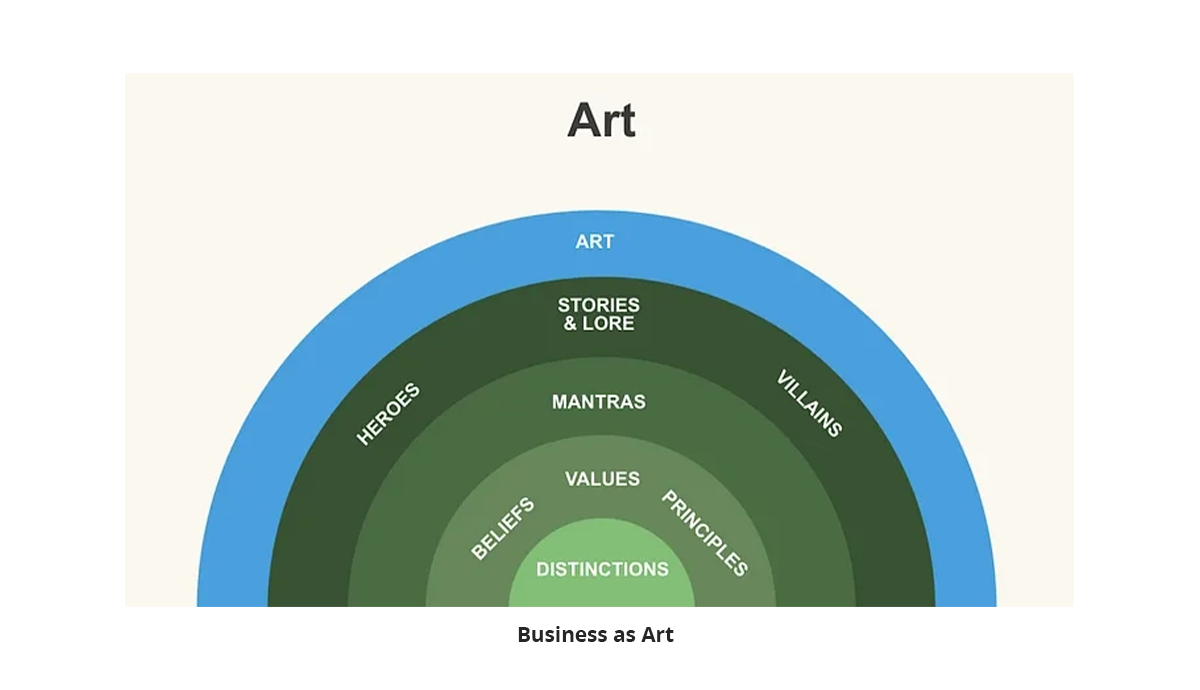
Art | Tradition | Rituals | Symbols. What would a culture be without its art? By art, I mean all of the various forms of art that come from any culture. In business, it manifests as our “brand,” in our logo and the symbols and iconography that we create for our day-to-day work. It also lives in the artifacts that we produce for the world, like our website, the documents that we print, or the videos that describe what we do. It also lives in the performance art that shows up in our rituals, traditions, ceremonies, and secret handshakes. The ways in which we celebrate our successes together, greet visitors when they walk through our doors, how we conduct our meetings and the music that we play in our phone tree are all important manifestations of our culture. A business is a work of art that is never complete and always evolving. It is expressed through its art every day.
Being good in business is the most fascinating form of art.
Our ceremonies, traditions, and rituals happen in cycles. Internally, there are our daily meetings, standups, and interactions, our weekly recurring meetings and updates, and our monthly, quarterly, and annual cadences. Each of these represents an opportunity to steward an experience that will have an impact on our culture. With our customers, every experience that we provide for them is an opportunity to create a worthwhile cultural memory and story. The best companies realize this and pay close attention to their traditions, ceremonies, and rituals.
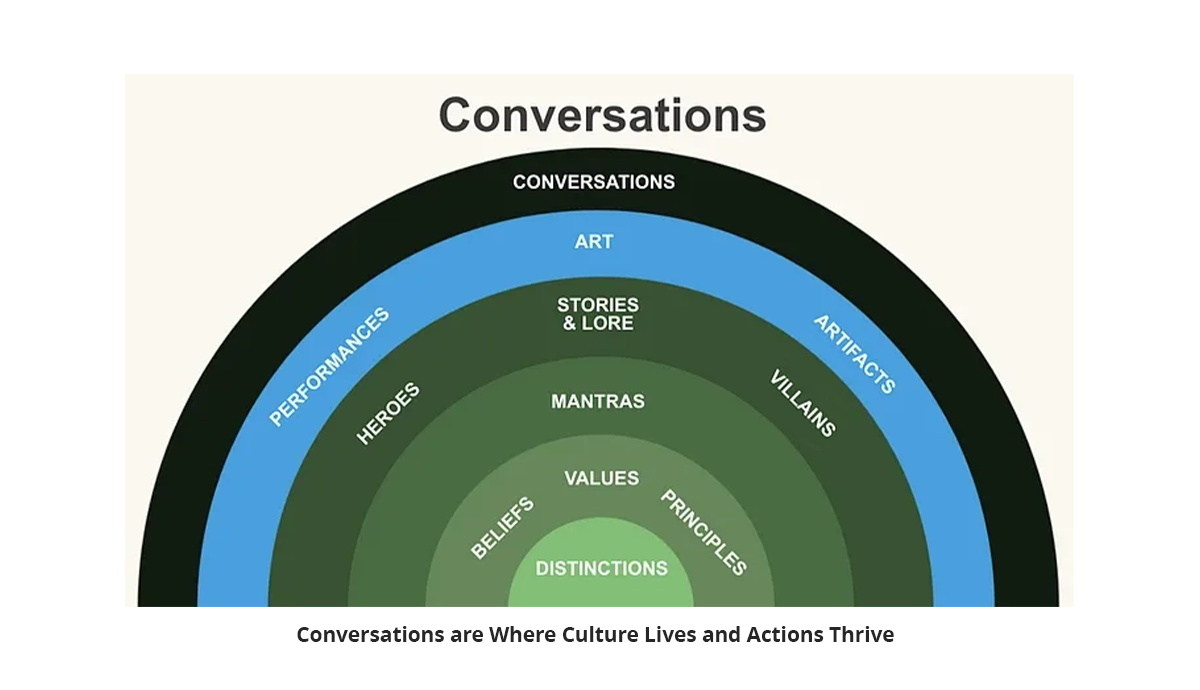
Conversations
None of the above layers is impactful until it has an impact on the conversations that occur in the hallways when the leaders are not around. It is in the conversations that culture lives every day. It is in the dialogs, discussions, arguments, celebrations, and meetings that the culture of a business is actually expressed. Unfortunately, leaders have very little control over these daily conversations unless they are in the room. In high functioning cultures, both the quality and the quantity of the conversations that occur lead to direct positive actions toward the group’s shared goals, without the leaders in the room.
Keeping a pulse on the actual conversations that are occurring and stories that are being told throughout the organization is a powerful way to steward the culture. The better a leadership team becomes at scaling the quality of the conversations and listening to the language that is working, the better the result. When we actually improve the quality and the quantity of the conversations that occur around a subject, we will see the needle move on the behaviors that are associated with it.
If we want people to care about a subject, they need to be talking about it and talking about how to change it for the better, together. Forcing people to sit through indoctrination classes may move the needle on their knowledge and understanding, but it will not create a sustainable, resilient culture for the organization. Resilience and adaptability come from the exhausting work of improving the conversations that are occurring every day throughout the organization.
Culture exists in the conversations that occur in the hallways when the leaders are not in the room.
Tell
If there are silos within your organization where great things are occurring and the culture is thriving through high-quality conversations, study these groups deeply. I have seen, countless times, where leaders see that a group is successful by doing something a little different and label it a silo. Even though it is working well, they swoop in and demand change because a process is not being followed or they don’t like the way a particular member of the group operates. In most cases, they feel as though they are losing control or that their leadership is threatened in some way. This is a rookie leadership mistake. These are the parts of your organization that might hold the keys to the future through their innovative capabilities and they need to be carefully curated.
The imperative with high-functioning silos is to learn from them and inspire them by telling their stories and training their peer organizations around what they have learned. Give them a stage upon which to tell their stories. Ask them to create classes or have them stand up and present in your all-hands meetings. Engage a marketing team to interview them to get their stories told. The goal is to integrate the great work they are doing into the rest of the organization. A great leader will work to connect these high-functioning teams and people to the impact their work will have. By telling their stories together, they will improve their team, the other teams in the organization, and the organization’s ability to better serve its customers. It should be a win-win scenario for all.
If you allow siloed organizations to operate in their bubble, it will only be a matter of time before the bubble either explodes and you lose the value of their learning because people leave and take their knowledge and skills with them or it implodes and the outside world surpasses their growth. The larger an organization and the faster the growth, the more important it is to keep an eye on these scenarios. The goal should always be to share knowledge and maximize the growth of the organization as a whole.
Craft
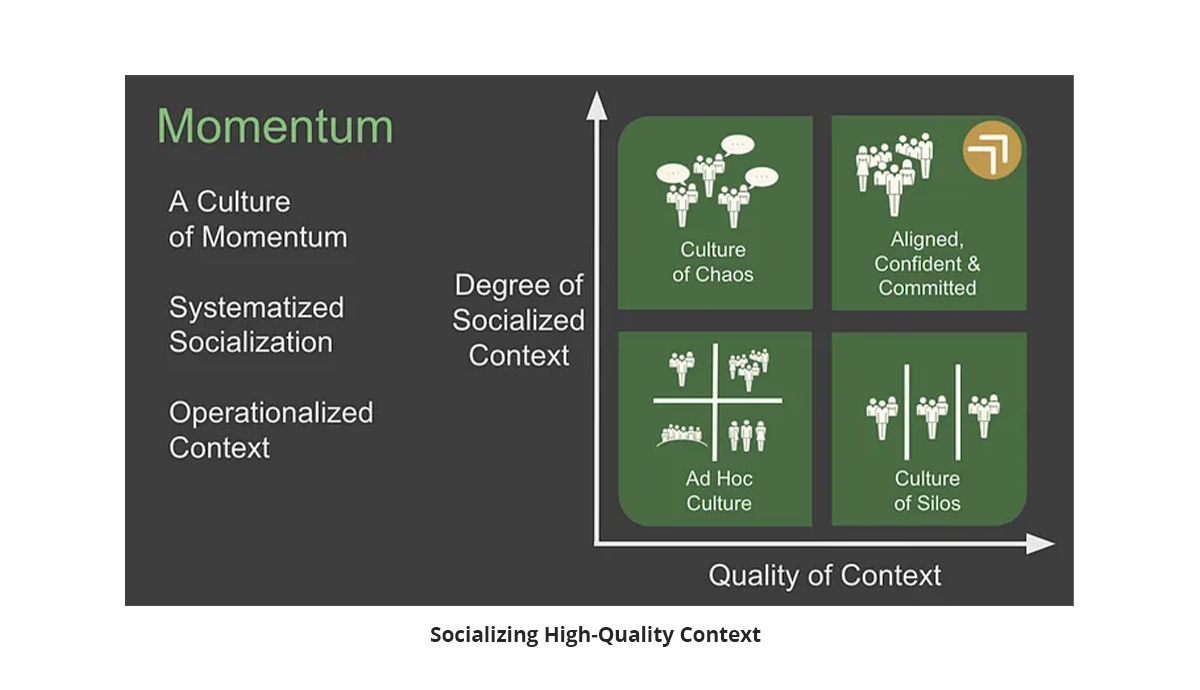
The bottom of the chart represents where I see many organizational cultures. In the lower-left quadrant, with low-quality conversations happening without much consistency, an ad-hoc culture exists. Teams are willy-nilly with their language, words are used inconsistently, few stories exist and there are few if any heroes. People figure out how to share context on the fly and in the moment and there is very little repetition of useful context. It is difficult to scale a positive culture like this. In the lower right-hand quadrant, there may be consistent and high quantity use of low-quality context. In this situation, a culture of chaos may exist. With poorly defined language, stories that don’t match the corporate mantras, and lots of “fake news” floating around, the culture will not contribute to high-quality actions resulting from the conversations. If the organization’s culture lies somewhere in the bottom two quadrants, start over. It is not a “chicken or an egg” problem. The culture has to start with the leadership purposefully crafting what they want the culture to look like and deploying it smartly by finding the words that are important, crafting some mantras, deploying them by example, and searching out and telling the stories around what works, including stories of heroes who save the day for the organization. And, telling the stories around what doesn’t work, those where the villains in the ecosystem are defeated wherever they might lie.
High performance cultures have consistent, powerful conversations fed by a purposeful lexicon, beliefs, mantras, supporting stories and art that result in momentum.
Action
When you have strong context feeding your culture, it is easier to scale the alignment of your teams. When you have a strong history of success expressed through stories and ways of being, it is easier to be confident. When all of these things are working well, it is easier to get your team committed to the actions that are needed to achieve a common set of goals. This combination of alignment, confidence, and commitment will result in a higher level of motivation from your team. This action, and this positive result, is “momentum.” Momentum manifests through the generation of authentic relationships between the people in your ecosystem. We will know we have it when we have a measured increase in Trust, Loyalty, and Advocacy in our business.
Amplification and Suppression
The best cultures adapt and evolve organically, thus the most powerful mantras and stories will emanate from within, through inspired people doing inspired work, and must be amplified by the leadership. When the mantras and stories are not working or have a negative impact, you must work with your teams to modify and suppress them. The faster you do that, the better. However, when the contextual elements of culture result in positive action, a leader’s job becomes to repeat them, encourage their use, celebrate them and amplify them as powerfully as you can. The leader’s role lies in the amplification of what works and the suppression of what doesn’t, in the context of your organization. The better job you do of hunting down the critical and more impactful elements of context, the more successful you will be. It is exhausting work.
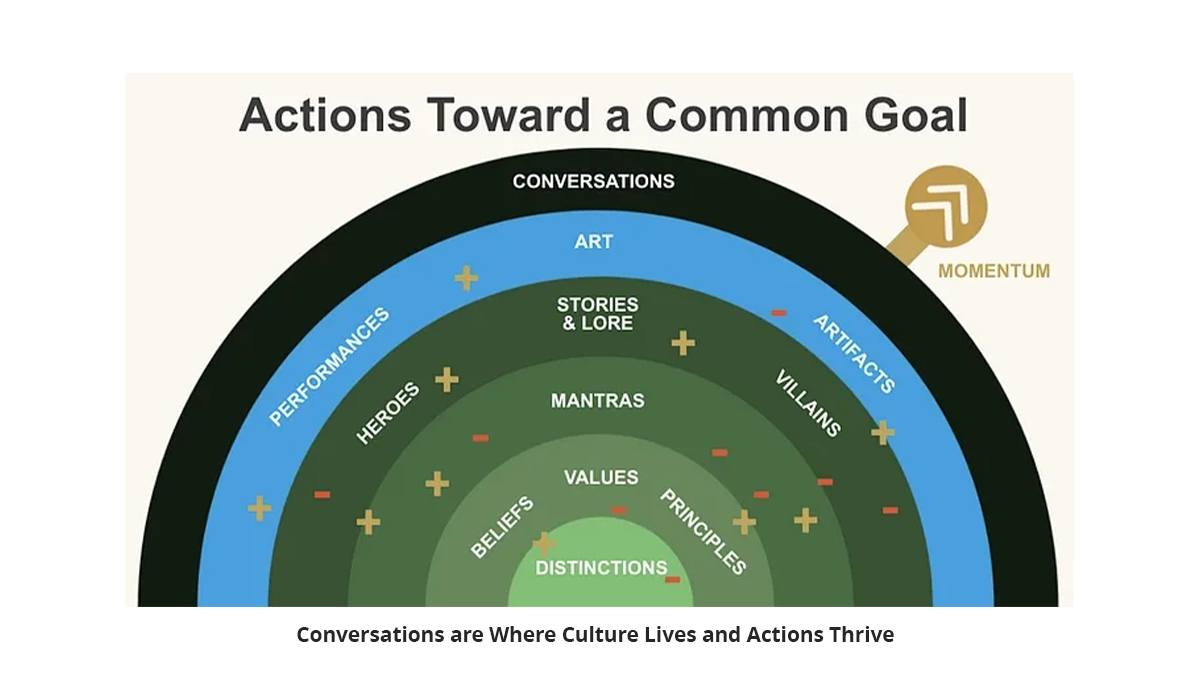
To address the quote from Peter Drucker from earlier, culture does not eat strategy for breakfast. Culture is an integral part of building a motivated team to achieve a meaningful vision. A strategy that includes an understanding of how culture, through language, relates to motivation and results in shared actions toward a positive result is one that is destined for success. The organization’s culture is the context in which the strategy is pursued and tactics are deployed. Culture, strategy, and tactics are deeply interrelated concepts that when working well together, form a healthy, thriving organization. You can have a culture without a strategy, lots of groups do. If you want to maximize the motivation of a group of people toward a shared goal, you need a definition of culture that results in action:
The context that binds people together and results in actions toward a common goal.
According to David Packard, we need to have a pulse on what is going on in the business. A phrase that he popularized in his book sums it up eloquently: “Management by walking around.” There is no substitute for getting out there and talking to your people at the ground level to find out what is happening day to day, or going out and visiting your customers and vendors. Keeping a pulse on the language, the mantras, and the lore that makes up the context of your culture will pay huge dividends to leaders. More importantly, leading through example, while creating this same expectation at all levels of your organization, will help you ensure that the culture stays healthy, and will have a direct impact on those conversations that are occurring when you are not in the room. It is these conversations that will inform the tactical decisions that your people make every day in the service of your customers.
References and Further Reading:
- Peter Drucker’s Quote: https://quoteinvestigator.com/2017/05/23/culture-eats/.
- The HP Way: How Bill Hewlett and I Built Our Company, by David Packard (2006).
- Great Leaders of Our Collective History, by Sean Flaherty (December 2019).
- Language and the Pursuit of Excellence, by Chalmers Brother (2015).
- Principles, by Ray Dalio (2017).
- The Culture Code, by Daniel Coyle (2018).
- Josh Anon Podcast, hosted by Sean Flaherty and Paul Gebel (January 2021).
- The Leadership Flip, by Sean Flaherty (March 2020).
- Measuring Relationships and Finding the North Star, by Sean Flaherty (November 2020).
- Inspiring Indicators of Performance (RPIs: Relationship Performance Indices), by Sean Flaherty (January 2019).

Sean Flaherty is Executive Vice President of Innovation at ITX, where he leads a passionate group of product specialists and technologists to solve complex client challenges. Developer of The Momentum Framework, Sean is also a prolific writer and award-winning speaker discussing the subjects of empathy, innovation, and leadership.



